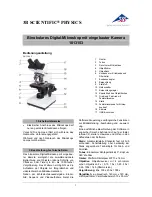
10
The finish of the microscope is hard epoxy and is resistant to acids and
reagents. Clean this surface with a damp cloth and mild detergent.
Periodically, the microscope should be disassembled, cleaned and
lubricated. This should only be done by a qualified, authorized
microscope technician.
DUST COVER AND STORAGE
– All microscopes should be protected from
dust by a dust cover when in storage or not in use. A dust cover is the
most cost-effective microscope insurance you can buy. Ensure that the
storage space is tall enough to allow the microscope to be placed into
the cabinet or onto a shelf without making undue contact with the
eyepieces. Never store microscopes in cabinets containing chemicals
which may corrode your microscope. Also, be sure that the objectives
are placed in the lowest possible position and the rotating head is turned
inward and not protruding from the base. Microscopes with mechanical
stages should be adjusted toward the center of the stage to prevent the
moveable arms of the mechanical stage from being damaged during
storage in the cabinet.
TENSION CONTROL OF FOCUSING MOVEMENT -
Tension of the focusing
movement is controlled by a tension system found on the pinion metal of
the rapid focus control. This can be adjusted by using the Swift part
#MT205 wrench.
BULB REPLACEMENT -
To prolong the life of the bulb you should always
turn off the unit when not in use. The replacement bulb part number can
be found underneath the microscope on the metal base plate. The
M3500DF models use a 5W fluorescent bulb Swift part number MA2202F.
The M3500CL models use a .06W LED Swift part number MA2215.
Summary of Contents for M3500 SERIES
Page 13: ......































